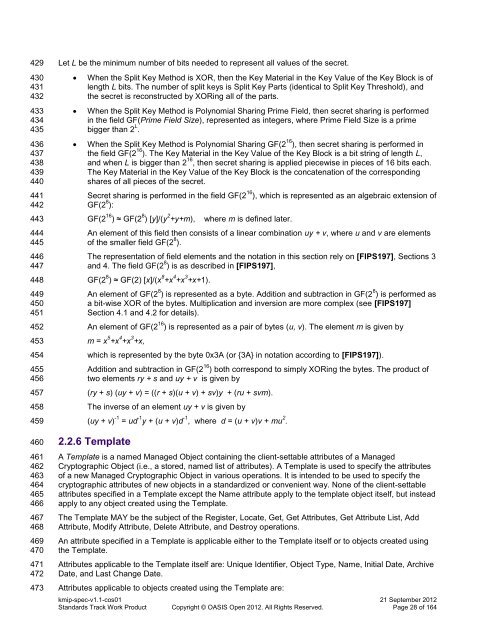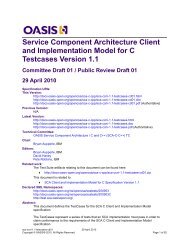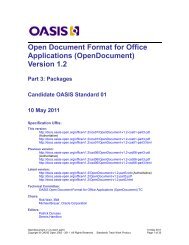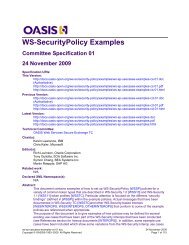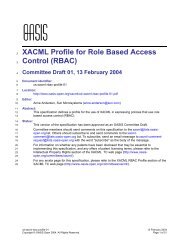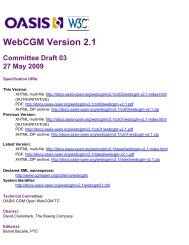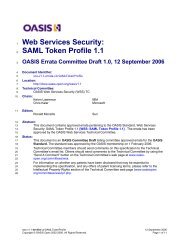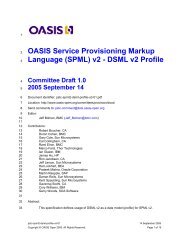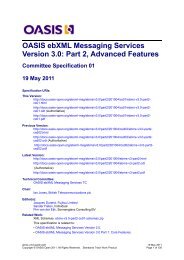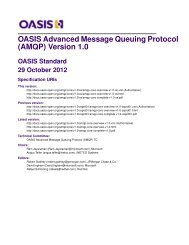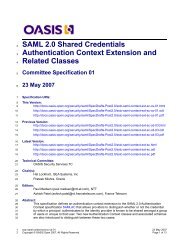Key Management Interoperability Protocol Specification Version 1.1
Key Management Interoperability Protocol Specification Version 1.1
Key Management Interoperability Protocol Specification Version 1.1
You also want an ePaper? Increase the reach of your titles
YUMPU automatically turns print PDFs into web optimized ePapers that Google loves.
429430431432433434435436437438439440441442443444445446447448449450451452453454455456457458459460461462463464465466467468469470471472473Let L be the minimum number of bits needed to represent all values of the secret.When the Split <strong>Key</strong> Method is XOR, then the <strong>Key</strong> Material in the <strong>Key</strong> Value of the <strong>Key</strong> Block is oflength L bits. The number of split keys is Split <strong>Key</strong> Parts (identical to Split <strong>Key</strong> Threshold), andthe secret is reconstructed by XORing all of the parts.When the Split <strong>Key</strong> Method is Polynomial Sharing Prime Field, then secret sharing is performedin the field GF(Prime Field Size), represented as integers, where Prime Field Size is a primebigger than 2 L .When the Split <strong>Key</strong> Method is Polynomial Sharing GF(2 16 ), then secret sharing is performed inthe field GF(2 16 ). The <strong>Key</strong> Material in the <strong>Key</strong> Value of the <strong>Key</strong> Block is a bit string of length L,and when L is bigger than 2 16 , then secret sharing is applied piecewise in pieces of 16 bits each.The <strong>Key</strong> Material in the <strong>Key</strong> Value of the <strong>Key</strong> Block is the concatenation of the correspondingshares of all pieces of the secret.Secret sharing is performed in the field GF(2 16 ), which is represented as an algebraic extension ofGF(2 8 ):GF(2 16 ) ≈ GF(2 8 ) [y]/(y 2 +y+m),where m is defined later.An element of this field then consists of a linear combination uy + v, where u and v are elementsof the smaller field GF(2 8 ).The representation of field elements and the notation in this section rely on [FIPS197], Sections 3and 4. The field GF(2 8 ) is as described in [FIPS197],GF(2 8 ) ≈ GF(2) [x]/(x 8 +x 4 +x 3 +x+1).An element of GF(2 8 ) is represented as a byte. Addition and subtraction in GF(2 8 ) is performed asa bit-wise XOR of the bytes. Multiplication and inversion are more complex (see [FIPS197]Section 4.1 and 4.2 for details).An element of GF(2 16 ) is represented as a pair of bytes (u, v). The element m is given bym = x 5 +x 4 +x 3 +x,which is represented by the byte 0x3A (or {3A} in notation according to [FIPS197]).Addition and subtraction in GF(2 16 ) both correspond to simply XORing the bytes. The product oftwo elements ry + s and uy + v is given by(ry + s) (uy + v) = ((r + s)(u + v) + sv)y + (ru + svm).The inverse of an element uy + v is given by(uy + v) -1 = ud -1 y + (u + v)d -1 , where d = (u + v)v + mu 2 .2.2.6 TemplateA Template is a named Managed Object containing the client-settable attributes of a ManagedCryptographic Object (i.e., a stored, named list of attributes). A Template is used to specify the attributesof a new Managed Cryptographic Object in various operations. It is intended to be used to specify thecryptographic attributes of new objects in a standardized or convenient way. None of the client-settableattributes specified in a Template except the Name attribute apply to the template object itself, but insteadapply to any object created using the Template.The Template MAY be the subject of the Register, Locate, Get, Get Attributes, Get Attribute List, AddAttribute, Modify Attribute, Delete Attribute, and Destroy operations.An attribute specified in a Template is applicable either to the Template itself or to objects created usingthe Template.Attributes applicable to the Template itself are: Unique Identifier, Object Type, Name, Initial Date, ArchiveDate, and Last Change Date.Attributes applicable to objects created using the Template are:kmip-spec-v<strong>1.1</strong>-cos01 21 September 2012Standards Track Work Product Copyright © OASIS Open 2012. All Rights Reserved. Page 28 of 164


